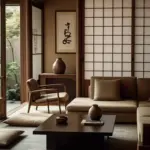Imagine your dining table not just as furniture, but as a gentle reminder of imperfection, presence, and timeless beauty. That’s the essence of a Wabi‑Sabi table—where nowhere near perfect is exactly the point. It’s rustic yet refined, humble but soulful, offering a space where you slow down, appreciate the material world, and find peace in the everyday.
























Understanding Wabi‑Sabi
Japanese Philosophy & Zen Roots
Wabi‑Sabi is a Japanese worldview that developed out of Zen Buddhism, particularly the practices surrounding the traditional tea ceremony. Wabi refers to a quiet, rustic simplicity and the beauty of living with less. Sabi refers to the patina of age, the grace that comes with time. The philosophy teaches us to find beauty in the naturally imperfect and to accept transience as an essential part of life.
Beyond Aesthetics: A Lifelong Approach
More than just a decor style, Wabi‑Sabi is a mindset. It encourages humility, mindfulness, and a deep appreciation for natural materials and forms. It promotes a lifestyle grounded in authenticity, where even flaws become features. Applying this to furniture, especially tables, means prioritizing craftsmanship and storytelling over mass production and artificial perfection.
What Makes a Wabi‑Sabi Table?
Embracing Imperfection, Impermanence & Simplicity
A Wabi‑Sabi table embodies the “Three I’s”: Imperfection, Impermanence, and Intimacy. It might have knots in the wood, uneven edges, or natural blemishes. These “flaws” are embraced as part of the table’s identity. Rather than polishing them away, the Wabi‑Sabi ethos encourages celebrating them as signs of life and time.
Natural Finishes & Muted Hues
Glossy, reflective surfaces are avoided. Instead, finishes are kept matte or raw, preserving the wood’s original texture. The color palette leans into earth tones: clay, charcoal, moss, sand, and soft whites. These tones bring a calming effect to the space, grounding it in nature and simplicity.
Materials & Craftsmanship
Reclaimed Wood
A staple in Wabi‑Sabi design, reclaimed wood tells a story. Every knot, dent, and weathered grain has history. This wood is typically salvaged from old buildings, barns, or driftwood, giving it a worn character that perfectly aligns with the aesthetic. Its imperfections aren’t viewed as defects but as visual poetry.
Stone, Clay & Ceramic Accents
Tables may incorporate stone tops, clay tiles, or ceramic details. These materials offer both visual and tactile contrast, adding weight and substance. They also connect the furniture to the natural world—a key principle in Wabi‑Sabi design.
Handcrafting Techniques & Visible Joints
Craftsmanship is central. Joints are often left visible, showcasing the skill and labor involved. Hand-carving, minimal machine use, and natural finishing techniques reinforce authenticity. The result is a piece that feels personal and lived-in, even if newly made.
Styling Tips for Your Table
Minimalism with Meaning
Styling should be intentional, not excessive. Think: one handmade bowl in the center or a small stack of natural linen napkins. Each object placed on the table should serve a purpose or have a story. The goal is to keep the space open and breathable.
Complementary Decor Elements
Pair your table with decor that supports the natural theme. Handmade ceramics, vintage cutlery, or a dried floral arrangement can add subtle character. Light sources should be warm and soft—think candles, paper lanterns, or diffused sunlight.
Integrating Wabi‑Sabi into Modern Interiors
Japandi & Scandinavian Pairings
Japandi, a fusion of Japanese and Scandinavian design, is the perfect partner. Both styles celebrate simplicity, functionality, and natural materials. A Wabi‑Sabi table becomes the grounding element in these interiors, surrounded by minimalist forms and cozy textures.
Contrast with Contemporary Elements
Wabi‑Sabi works beautifully as a contrast piece. Try pairing it with sleek, modern chairs, a polished concrete floor, or minimalist pendant lighting. This contrast enhances the table’s warmth and texture, making it a standout focal point.
Popular Design Variations
Live‑Edge Slabs
Live-edge tables keep the natural contour of the tree. These edges are irregular, often asymmetrical, and add organic movement to the piece. No two live-edge slabs are alike, making them ideal for Wabi‑Sabi aesthetics.
Low‑Profile & Sectional Tables
Inspired by traditional Japanese dining tables, low-profile Wabi‑Sabi tables promote grounding and calm. Sectional pieces may come apart or shift in use, adapting to different moments and emphasizing flexibility and impermanence.
Mixed‑Material Surfaces
Wood can be combined with elements like concrete, brass, or tile for added texture. These combinations invite touch and exploration, making the table more interactive and visually engaging.
Benefits of Owning a Wabi‑Sabi Table
Mindfulness & Emotional Calm
The natural imperfections of the table remind us to slow down and accept things as they are. Sitting at a Wabi‑Sabi table becomes a grounding experience—a daily reminder to be present.
Eco‑Conscious Style
Wabi‑Sabi values sustainability. Many tables are made from salvaged or naturally aged materials, reducing waste and avoiding the energy demands of mass manufacturing.
Character and Storytelling
Every Wabi‑Sabi table is unique. Its textures, lines, and marks form a narrative that deepens over time. Guests will notice the difference—this isn’t just furniture, it’s artful living.
DIY & Buying Guide
Sourcing Reclaimed Material
Find old wood at salvage yards, estate sales, or through local builders. Look for signs of natural wear like cracks, nail holes, or darkened grain.
DIY Build Steps
Start with a cleaned, sanded piece of reclaimed wood. Apply natural oil or wax—not synthetic varnish. Choose minimalistic legs or hand-assembled joinery. Keep lines simple and celebrate flaws instead of hiding them.
What to Look for When Shopping
Prioritize genuine materials. Avoid fake distressing. Look for hand-built construction and solid wood (not veneers). Ask about the source of the materials—the more story it has, the better.
Common Mistakes to Avoid
Over‑styling
Wabi‑Sabi thrives on breathing room. Avoid crowding the table with centerpieces, candles, and decor. Let its texture and shape shine.
Fake Wear
Artificial distressing or mass-produced “rustic” furniture often lacks authenticity. Wabi‑Sabi celebrates honest imperfection, not forced damage.
Material Mismatch
Be mindful of coherence. Mixing your Wabi‑Sabi table with overly glossy, synthetic, or plastic-heavy elements can clash with the natural narrative.
A Wabi‑Sabi table is more than a place to eat—it’s a visual and tactile reminder of nature, impermanence, and mindful living. Whether hand-built or lovingly sourced, it invites calm, slows us down, and adds soul to any space. Through organic textures, humble materials, and quiet strength, the Wabi‑Sabi table becomes the beating heart of a meaningful home.


